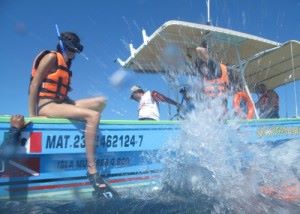By: Genna Marie
Yep.
That’s right. The rumors are true: this June there were at least two confirmed whale shark sightings near Las Catalinas, a popular dive site just 15 miles off the coast of Tamarindo (and only 8 miles from Flamingo).
Compared to other pelagic sea creatures, whale shark sightings are rather uncommon and unpredictable in most parts of the world. (For all of you non-divers, pelagic just means ‘open sea.’)
In fact for many scuba divers, spotting a whale shark is like finding the underwater holy grail. With the exception of a few select places – like the Caribbean islands of Roatan and Utila in Honduras and off Islas Mujeres in Mexico’s Yucatan – finding a whale shark is no easy task.
Despite the whale shark’s immense size and terrifying name, these gentle giants thrive on nothing but plankton and whatever other small creatures get sucked into their gaping mouths as they soar through the water. They’re pretty much as harmless to humans as fruit flies.
A recent study done by biologists at the University of South Florida estimates that a single whale shark could filter all of the water in an Olympic-sized swimming pool in a mere four hours. (Don’t try this at home.)
Whale Shark Fast Facts:

Each whale shark’s pattern is as unique as a human fingerprint.
Whale sharks are the largest fish in the sea.
This gentle giant is a shark, NOT a whale. A whale-of-a-shark, if you will.
They like warm, tropical waters.
According to National Geographic, the average whale shark is between 18 to 32.8 ft (5.5 to 10 m) long and weighs about 20.6 tons.
Whale sharks are threatened but not yet on the endangered species list.
These huge creatures are like the cows of the sea – they aren’t quick. Most swim at rates no faster than about 5 miles per hour.
Other Places to See Whale Sharks in Costa Rica

Aside from Las Catalinas Islands, whale sharks are occasionally sighted at most major dive locations on the Pacific coast – including the waters around Playas del Cocos, Islas Murciélagos (Bat Islands), Isla del Caño (on the Osa Peninsula), and Playa Jacó/Herradura. Of course they are also sometimes spotted out at Cocos Island, but that’s 36 hours offshore.
Photo Credits:
Photos courtesy of Tamarindo Family Photos.


